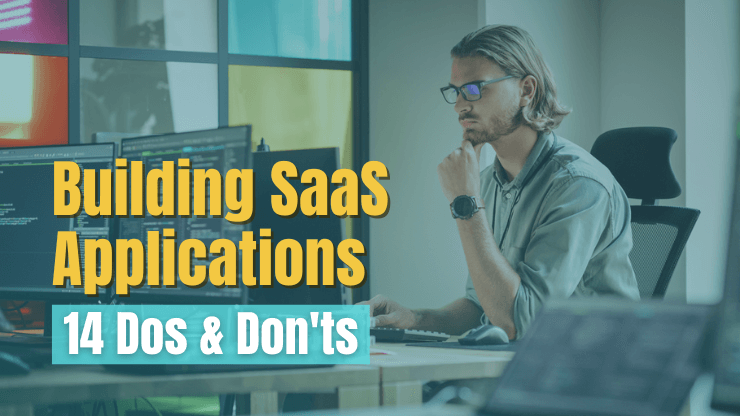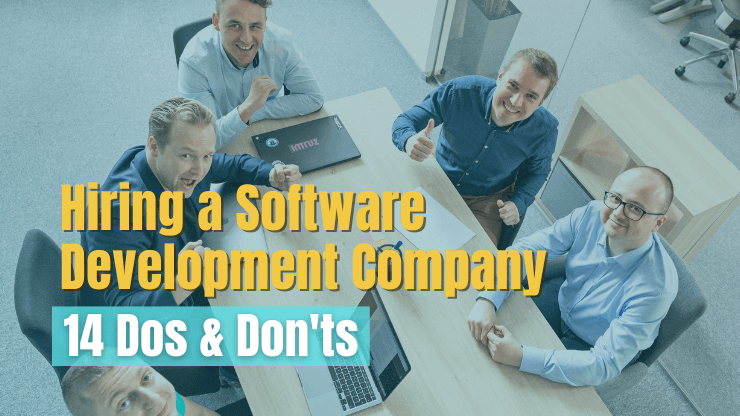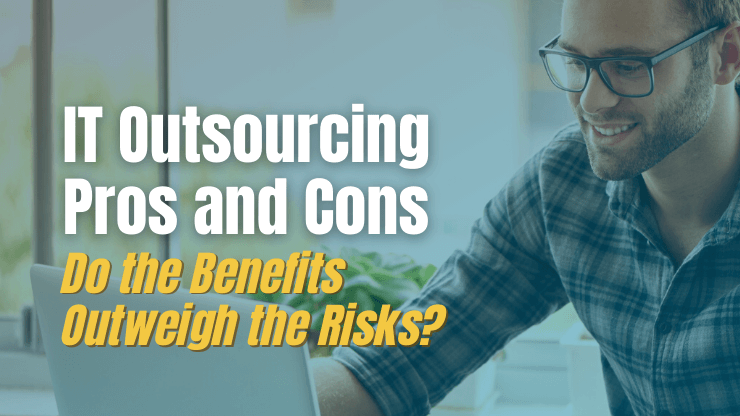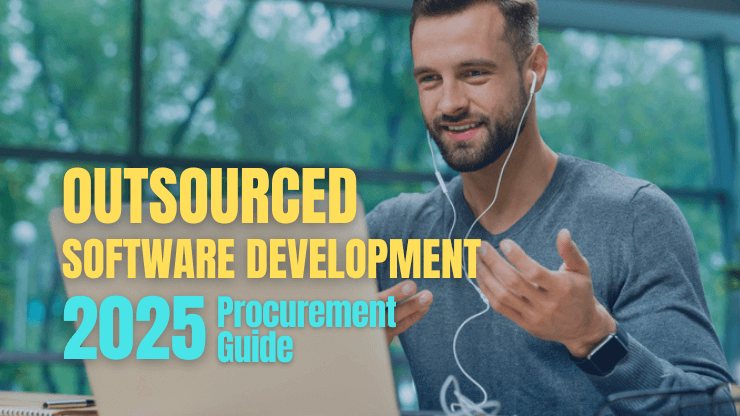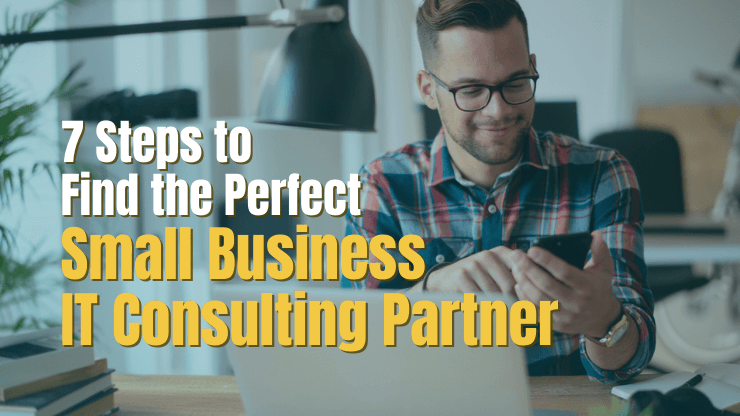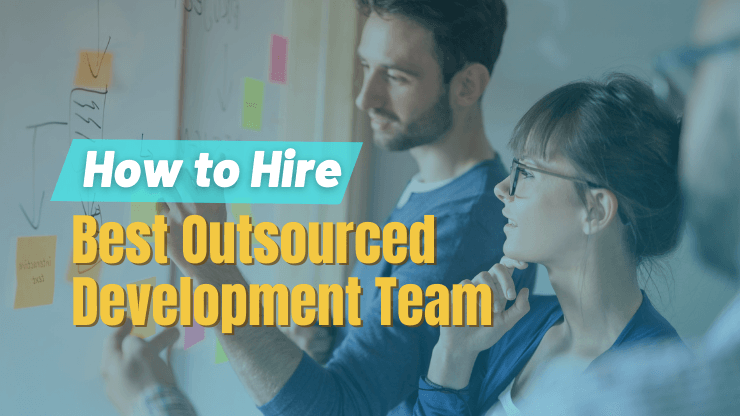The rapidly evolving Software-as-a-Service (SaaS) market, now surpassing $146B globally invites relentless competition and high expectations from customers.
Building SaaS application in 2025 requires more than just an innovative idea - it requires thoughtful planning, fast execution, and leveraging user feedback to make data-driven decisions.
In this article, we will provide you with this guidance along with the essential insights and strategies you need to realize your product vision and deliver a SaaS application that users love.
Understanding SaaS development challenges
SaaS application development is a complex and dynamic process that comes with many uncertainties and challenges. Software development risks can have serious consequences for SaaS software development projects, such as:
- Project delays: SaaS development is a complex and dynamic process, and there are multiple factors that can cause delays. Changes in requirements, technical issues, and resource constraints can lead to project delays.
- Cost overruns: This could be due to unexpected technical challenges, new feature requests, or changes in the market landscape. SaaS developers must carefully manage their resources and budget to avoid cost overruns.
- Customer dissatisfaction: It can be challenging to create a product that aligns with customers' needs and preferences. Failure to do so can result in dissatisfied customers, negative reviews, and loss of market share.
Navigating the complexities of SaaS development requires more than just identifying challenges; it demands foresight and decisive action.
Developing SaaS Applications - Do’s
Let's transition from problem identification to solution-seeking to tangible strategies and best practices for those developing SaaS apps:
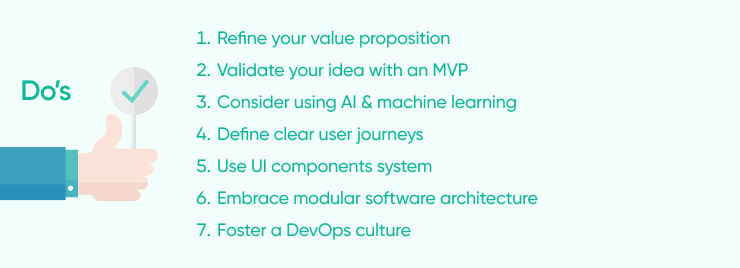
Refine your value proposition
In the crowded SaaS market, it's crucial that your SaaS apps offer a unique solution to an existing problem. In other words, a SaaS app should have a refined value proposition, which is a brief statement that outlines what your product or service can do for customers. A well-articulated value proposition not only appeals to your customer's needs and wants but also communicates the uniqueness of your product.
A value proposition should:
- Highlight the main benefits of your SaaS app. This is the heart of your value proposition.
- Detail the problem it solves for its customers. Every viable product solves a real customer problem.
- Compare your SaaS app against others in the market. This should be based on real market research.
- Be agreed on by all major stakeholders in the company. It’s critical to have alignment on this foundational information before proceeding with SaaS application development.
- Be used as a jumping off point for marketing collateral, messaging, and your product’s tagline.
PRO TIP: Every SaaS app, from an enterprise resource planning (ERP) tool to a CRM, needs to have a value proposition that is aligned to how it will fill a gap in the market.
To find a gap in the market, you need to evaluate the competition by looking at the SaaS applications that are already on the market and determine what your SaaS platform will offer that is different or better. It can also be helpful to look at the pricing of similar products and decide where your product will fit in.
Keep in mind, Sometimes it’s about...
- solving a customer pain point in a better or more directly.
- solving a customer pain point in a new or different way.
- solving a customer pain point at a lower cost.
Read More: How to Write a Tech Startup Business Plan to Win Investors
Validate your idea with an MVP
Before investing significant resources into fully developing your SaaS application, it's essential to validate your idea in the real world. This is where a Minimum Viable Product (MVP) comes in. An MVP is a basic version of your SaaS application that has enough features to be usable by early customers who can then provide feedback for future product development.
The main goal is to test the market's response to your product before fully committing. This helps minimize the risk of launching a SaaS product that may not be accepted by the market, saving you time, money, and effort in the long run.

PRO TIP: Keep it simple by focusing on solving one big problem. A good question to ask is “is it possible to launch the SaaS app without this” or “could the customer still complete their journey without this item.” Do you really need that integration, or could it be managed manually?
Read More: How to Build a Minimum Viable Product in 5 Steps [+ Template]
Consider using AI & machine learning
In the highly competitive SaaS landscape, differentiating your SaaS product can make the difference between success and obscurity. Leveraging AI to build a SaaS application better, faster, or more intelligently can set you apart. Using AI and ML during a SaaS project can help you team to:
- Enhance functionality: Identify opportunities in your SaaS application where AI and ML can enhance functionality. These could include process automation, personalized recommendations built right into the SaaS software UI, predictive analytics, or user behavior analysis.
- Automate tasks: The development team and product team can use AI tools to automate routine tasks and simplify the SaaS development process. Saas developers can leverage AI coding assistants to accelerate software development.
- Business development: You can use AI sales tools to optimize your proposed SaaS model, better understand the user experience, and more. Look for BI or competitive analysis tools that are driven by AI.
- Content generation: Leverage AI marketing tools for creative outputs like blog content, website copy, and outreach emails.
PRO TIP: Your team should understand that tools like OpenAI have limitations and potential risks, such as limited language availability, inconsistent responses, and the possibility of biased or offensive outputs. Ensure its use is appropriate for your SaaS application's needs and audience.
Read More: 7 Proven Ways SaaS Startups Can Leverage GPT3 OpenAI API
Define clear user journeys
A user journey represents the different stages a user goes through while interacting with your SaaS application. It starts from the initial point of contact or discovery, through various touchpoints, and eventually to a desired action (like subscribing to your SaaS app service or generating a report within the Saas app). Understanding and defining these user journeys are crucial because they help ensure that your users have a smooth, satisfying experience with your product (both before and after they subscribe).
PRO TIP: Storyboarding is a powerful tool that brings your user's journey to life. A storyboard is a low-fidelity visual representation that focuses on the user's actions, thoughts, goals, emotions, and relationships throughout their interaction with your software.
Create a story map with a tool like Miro to organize user stories into a visual representation that illustrates the relationships between stories and helps prioritize their implementation.
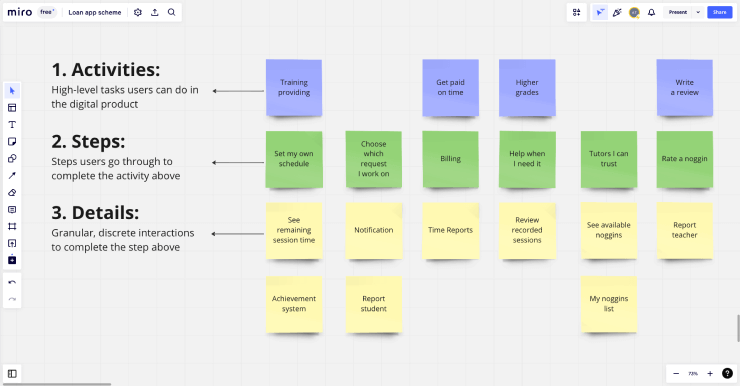
Use UI components system
Ready to use UI components can significantly accelerate the SaaS app development process, as they simplify UX/UI design and provide all the necessary visual components of a software application, allowing development teams to swiftly construct the user interface and design elements.
When developing SaaS solutions, you can consider front-end development frameworks such as:
- TailwindUI: A highly customizable, low-level CSS framework for rapidly building modern user interfaces, providing a deep set of design primitives to build with.
- Material UI: A popular React UI framework that implements Google's Material Design for faster and easier web development.
- Ant Design: A design system for enterprise-level products, offering a set of high-quality React components that are ideal for developing and serving enterprise-grade applications.
Embrace modular software architecture
Modular software architecture offers an effective approach for teams dealing with the development of complex SaaS applications. This technique allows a high degree of scalability and flexibility, enabling modules to be added or removed as necessary. Its compartmentalized nature facilitates independent development on individual parts, accelerating the building process when managed by an experienced team.
PRO TIP: Assess your application's complexity and your team's proficiency before deciding on a modular architecture. If your SaaS application is complex and your team is well-versed in modular development, this approach can enhance scalability and speed up the development process. But remember, a modular approach isn't always the right fit; it's most effective when it matches the application's scale and the team's skill set.
Read More: 9 Proven Shortcuts for Faster SaaS Application Development
Foster a DevOps culture
Adopting a DevOps culture in your SaaS development process is vital to streamline operations and achieve accelerated software delivery. DevOps is not simply a working methodology but a cultural shift that merges the traditionally separate roles of software development and IT operations. When effectively implemented, DevOps can lead to continuous delivery, faster problem resolution, and a more responsive and innovative application.
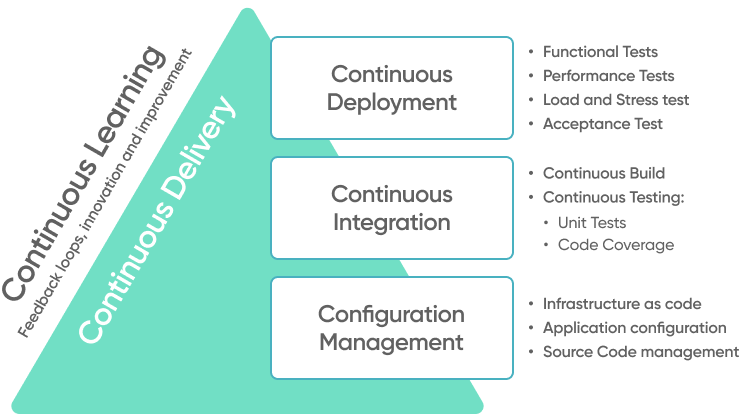
PRO TIP: Continuous improvement is a fundamental aspect of DevOps culture, influencing practices like Continuous Integration, Continuous Delivery/Deployment (CI/CD), Infrastructure as Code (IAC), automated testing, and monitoring. DevOps encourages frequent integrations, allowing for the rapid detection of problems, and any changes can be deployed securely and efficiently, enabling consistent product and process refinement.
Read More: DevOps Consulting Company - DevOps Strategy Consulting
Developing SaaS Applications - Don’ts
Having explored the best practices for SaaS application development, it's equally crucial to be aware of potential pitfalls. Here we'll steer you away from common oversights by highlighting what not to do when developing SaaS apps. Let's dive in.
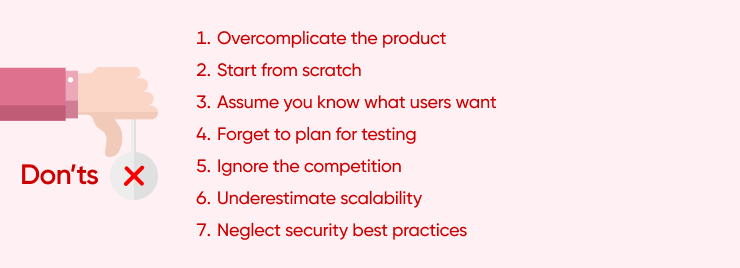
Overcomplicate the product
While it's tempting to integrate as many features and functionalities as possible into your SaaS application, this can often lead to an overly complex and cumbersome user interface (UI) and user experience (UX). Complexity not only makes the maintenance difficult but can also deter users, affecting your overall user retention.

PRO TIP: Occam’s Razor is a scientific and philosophical rule that states that the simplest answer is usually the correct one. Embracing this principle in your SaaS design can help to prioritize simplicity. To help embrace this principle:
- Hide the complexity behind feature with good SaaS design.
- Make sure all of your functions are self-explanatory.
- Maintain visual and functional simplicity wherever possible.
- When in doubt, go with the simplest option.
Read More: How to Design a SaaS Product Users Will Love [with examples]
Start from scratch
Developing software as a service products (or even traditional software) requires significant resources and financial investment. Instead of starting the process from scratch, you can use a SaaS boilerplate to speed up the developing process. A SaaS boilerplate acts as a web app template that has been specifically designed for use with SaaS applications. SaaS boilerplates typically include everything that is needed to launch a complete SaaS platform, including all the necessary pages, graphics, and functionality.
Some examples of SaaS boilerplates are SaaS Pegasus and Jumpstart Pro.
PRO TIP: The aim should be to strike a balance between utilizing the ready-made elements in the boilerplate and making necessary customizations that suit your SaaS business model. Be thoughtful about which elements to retain, adjust, or remove, always keeping in mind the needs of your users and your unique value proposition. Avoid over-customization, as it could negate the benefits of time and effort savings that a boilerplate provides
Read More: 9 Proven Shortcuts for Faster SaaS Application Development
Assume you know what users want
While it's important to start with a clear vision of your product, it's equally crucial to recognize that your perspective might not always align with your users' actual needs or preferences. This is particularly relevant in SaaS application development, where the success of your SaaS app depends largely on its user adoption and satisfaction rates.
To understand your users, consider:
- Engaging with your target market: Start by interacting with potential users to learn their needs, goals, and daily challenges. Observe them in their environment to gain insights into their habits and pain points. Use these observations to shape user-focused SaaS solutions.
- Surveying potential users: Surveys provide a wider view of your target market. Don't just focus on your software as a service product; explore your users' overall experiences. Discover their interests, main concerns, pain points, and favorite web apps. Use this feedback to align your SaaS applications with your users’ expectations.
PRO TIP: To maximize the effectiveness of surveys and interviews with potential users, utilize a user or customer feedback tool to systematically gather input.
- If you’re looking to distribute a simple survey, consider a tool like Typeform that provides a modern and engaging experience for survey-takers.
- If you’re looking to get more detailed feedback as part of an interview or survey, consider a tool like usersnap that allows users to tag specific areas of the software that they want to comment on. This can work well if you are replacing an existing software or want to understand how users utilize similar software tools to what you are going to build.
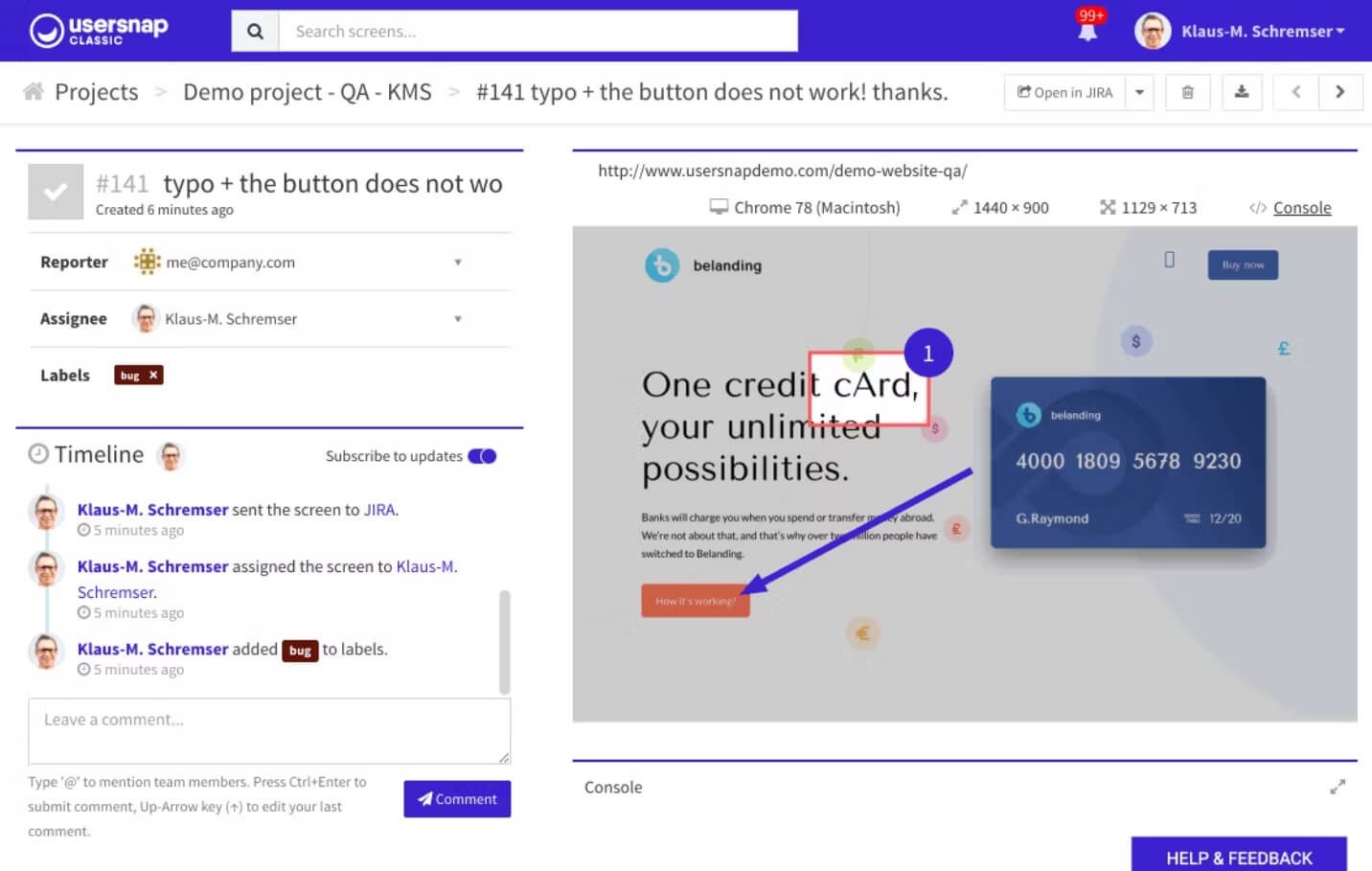
Forget to plan for testing
One mistake that can come at a great cost in SaaS development is neglecting to plan for testing. While it can be tempting to push forward with SaaS development and leave testing until the end, this approach often leads to issues being discovered too late in the process, which can be time-consuming and costly to fix. It also risks delivering a product that does not meet user expectations in terms of quality and reliability.
PRO TIP: Automated testing can supplement manual testing efforts, providing a fast and efficient way to run repetitive tests and identify issues. This allows more focus on complex testing scenarios in manual testing. Consider tools such as:
- Cypress: A front-end tool for fast and reliable testing in a browser, providing real-time tests and easy debugging.
- Playwright: A Node.js library for automating multiple browsers, supporting a range of features and conditions, ideal for comprehensive browser coverage.
- Selenium: An open-source tool for automating web browsers across platforms, suitable for projects with complex workflows, including mobile web app testing.
Read More: 10 Proven Steps to Quickly Write a QA Test Plan
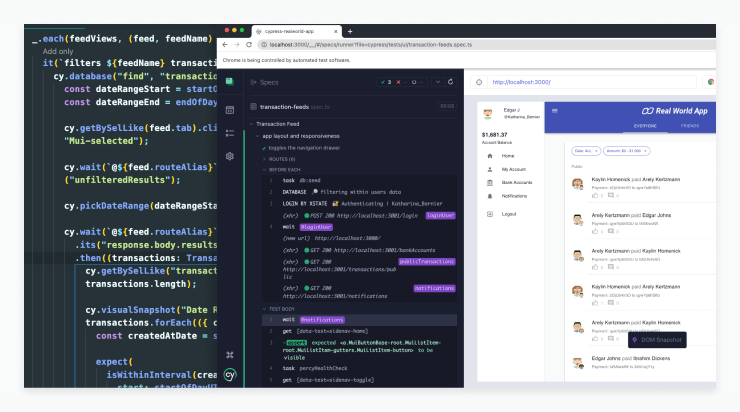
Ignore the competition
It's critical to understand that the SaaS market is highly competitive and ignoring your competitors can lead to missed opportunities and potential strategic pitfalls in your pricing strategy, subscription model, or other critical aspects of your SaaS business plan and design. We recommend you:
- Regularly monitor competitors: Conduct regular competitive analysis to keep abreast of what others in your space are doing. This will help you identify trends, gaps, and potential threats in the market.
- Learn from their successes and mistakes: You can gain valuable insights from observing your competitors' customer reviews and feedback.
- Differentiate your product: Understanding your competition can also help you identify ways to make your product stand out.
PRO TIP: Consider using competitive intelligence tools to automate the process of tracking and analyzing your competitors.
- Ahrefs - Excellent tool for tracking your own SEO, PPC, and content marketing metrics against the competition. The "Content Gap" tool, uncovers keywords your competitors rank for, spotlighting potential opportunities for your SaaS marketing strategy.
- SparkToro – Offers comprehensive audience intelligence, aiding SaaS teams in tailoring applications to user needs. The "Audience Insights" is particularly nice - highlighting where users engage online, allowing teams to effectively reach potential customers.
- BuzzSumo - Great for content research and monitoring. The "Content Alerts" feature provides real-time updates on specific topics, which can help you minimize manual research and monitoring
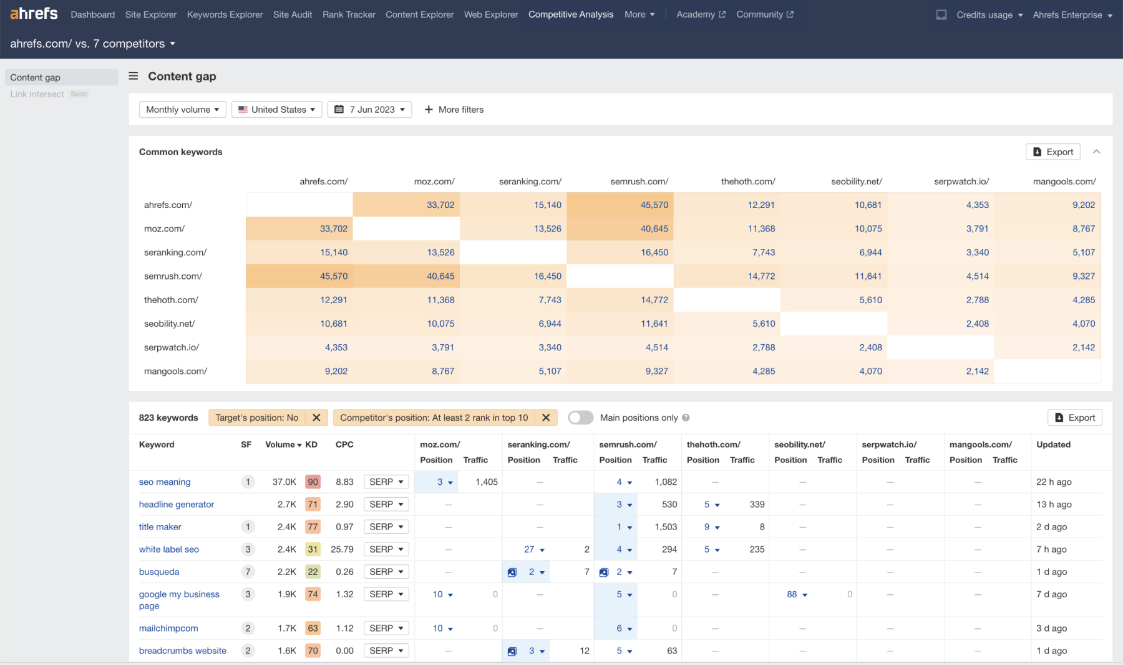
Underestimate scalability
Scalability is a critical factor that can determine the long-term success of a SaaS application. Failing to account for the need for scalability long-term can lead to performance issues, decreased user satisfaction, and potentially costly infrastructure overhauls.
The technology stack you choose plays a crucial role in the scalability of your application. Some technologies are better suited to scale than others, so it's worth taking the time to select the right tools for your needs.
Neglect security best practices
In an era where data breaches and cyber threats are prevalent, overlooking security practices can be a fatal mistake for any SaaS application. Ignoring the importance of robust security can lead to disastrous consequences, including loss of trust, reputational damage, legal ramifications, and financial loss. We recommend you:
- Implement security from the start: Incorporate security from the outset of the development process. It's more efficient and cost-effective than fixing vulnerabilities later on.
- Stay informed: With the rapidly evolving cybersecurity landscape, keep abreast of the latest threats and defense mechanisms.
- Adhere to regulatory compliance: Compliance with regulations such as GDPR, CCPA, or HIPAA is critical, depending on your application's nature and target market. Non-adherence can lead to substantial fines and penalties.
PRO TIP: Regular security audits are a proactive way to uncover vulnerabilities and gaps in your SaaS application. By routinely testing and scanning your system, you can stay one step ahead of potential threats, thereby ensuring the ongoing trust and loyalty of your users.
Conclusion
The development of a successful SaaS application in 2025 requires thoughtful planning, strategic decision-making, and adherence to proven methodologies. In this article we highlighted 14 “do’s and don’ts” to help you begin developing SaaS applications with greater confidence.
If you’re looking for a MVP software development partner to help bring your vision to life, we’d love to help. Our SaaS application development company will help you plan, design and build a successful product. Reach out for a free quote!

